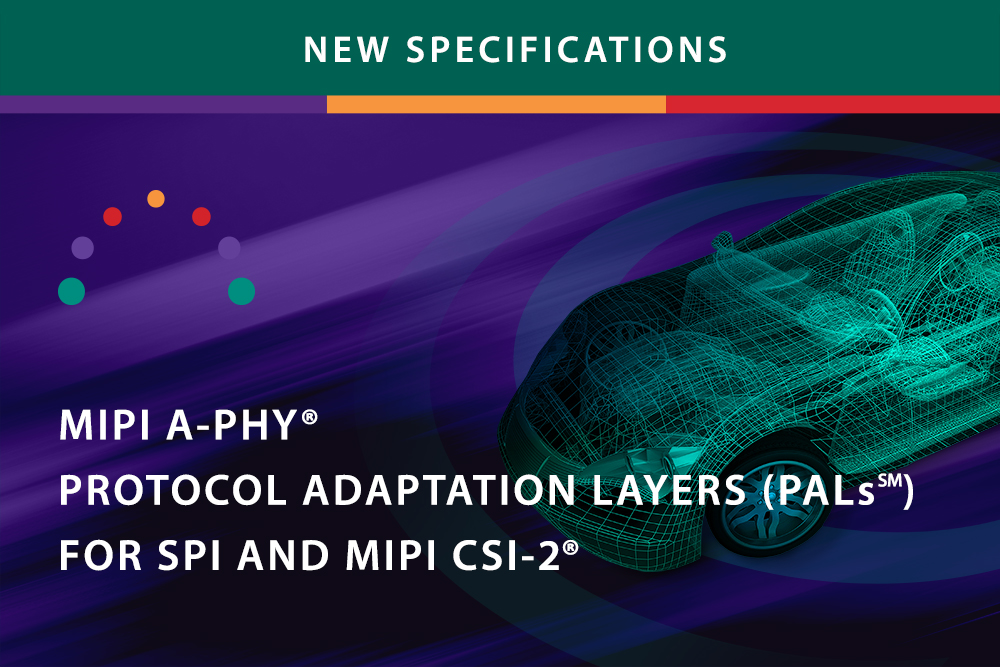2 min read
New PAL/SPI and Updated PAL/CSI-2 Extend Options for A-PHY Implementation in Automotive
![]() Nadav Banet, Lead, MIPI Camera Adaptation Layer Subgroup
:
30 August 2023
Nadav Banet, Lead, MIPI Camera Adaptation Layer Subgroup
:
30 August 2023

- News & Events
- News
- Blog
With the introduction of a new MIPI A-PHY® Protocol Adaptation Layer (MIPI PAL℠) for SPI and added features to another PAL for MIPI Camera Serial Interface 2 (MIPI CSI-2®), MIPI continues to expand and enhance the ways in which automotive designers can leverage existing protocols with A-PHY, the long-reach asymmetric serializer-deserializer (SerDes) specification for data transfer from automotive cameras, image sensors and displays to their associated electronic control units (ECUs).
The MIPI PAL specifications map video, audio and control data to A-PHY's A-Packet format, acting as a conduit to and from A-PHY’s generic data link layer, and rendering the higher-layer protocols effectively and natively connected. The modularity of MIPI’s portfolio of similarly structured PALs helps automotive designers relatively easily bring additional protocols onto their vehicle networks, while containing the cost of implementation.
Other PALs already available include those for MIPI Display Serial Interface 2 (MIPI DSI-2℠), Embedded DisplayPort and DisplayPort (eDP-DP) from VESA (Video Electronics Standards Association), I2C, Ethernet and GPIO. Plus, a PAL for the MIPI I3C® utility and control bus interface is currently in development. All PALs are available to MIPI Alliance members.
Together, these PALs are key components of the MIPI Automotive SerDes Solutions (MASS) framework, an end-to-end, full-stack of connectivity solutions with built-in functional safety and security. The framework offers a standardized approach to support advanced driver assistance systems (ADAS), autonomous driving systems (ADS), in-vehicle infotainment (IVI) and other surround-sensor applications.
New PAL for SPI
Adopted in April 2023, the new MIPI PAL/SPI v1.0 allows native peripheral devices using legacy Serial Peripheral Interface in radar and other applications to tunnel control information over A-PHY.
PAL/SPI is indicative of the flexibility that MIPI strives to achieve in supporting the precise needs of varied application designers. SPI natively has zero latency—data is instantly sent and received. PAL/SPI, consequently, has been engineered with multiple modes to enable designers to weigh tradeoffs among protocol overhead and latency and throughput over long distance to best meet their particular application requirements.
Updated PAL for CSI-2
MIPI PAL/CSI-2 v1.1, released in late 2022, provides more advanced time synchronization for the widely embedded CSI-2 over A-PHY. This update demonstrates MIPI’s commitment to keeping pace with innovation in the higher-layer protocols that the PALs support. Introduction of the new timing support in PAL/CSI-2 v1.1, for example, takes advantage of the clock-forwarding feature in A-PHY to allow applications that require synchronization of images captured across sensor arrays or different sensors located in different locations in a network. Each frame is timestamped so a controller can synchronize images, even when delivery delays differ among sensors or across a network topology.
PAL/CSI-2 v1.1 also introduces Service Extension Packet Data Type (SEP-DT) substitution to improve legacy support and, again, extend flexibility to designers to make choices based on their specific application needs. The SEP-DT format is used to implement the MIPI Camera Service Extensions (MIPI CSE℠) specification defining functional safety and other extended functions for CSI-2 over a PHY link. SEP is MIPI PHY-agnostic, allowing for data transfers over heterogeneous combinations of physical-layer interfaces, lane configurations and symbol rates, and addressing ISO 26262 requirements for error detection in data packets transmitted from source to destination end to end.
Seamless Integration of Higher-Layer Protocols
In other PAL activity, the PAL for I2C was also recently updated to v1.0.1 to replace the terms “master” and “slave” with “controller” and “target,” respectively. These changes were part of an initiative recommended by the MIPI Technical Steering Group (TSG) and directed by the MIPI Board of Directors to replace objectionable terms in MIPI specifications and supporting documents.
Interest in A-PHY is growing across the global automotive ecosystem as cameras, sensors and displays in the world’s vehicles continue to expand in number, complexity, bandwidth and interoperability requirements. Standardized interfaces such as A-PHY convey greater supplier choice and economies of scale, design simplicity and slashed costs. By defining the necessary flows, mechanisms and adaptations, the MIPI PALs serve as the “glue” that enables individual higher-layer protocols to operate seamlessly over A-PHY physical links.






